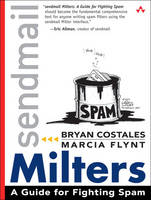
sendmail Milters
Addison-Wesley Educational Publishers Inc (Verlag)
978-0-321-21333-4 (ISBN)
- Titel ist leider vergriffen;
keine Neuauflage - Artikel merken
"Bryan and Marcia have not only provided tips and tricks for detecting and blocking spam and email fraud but have also written the first of its kind Milter reference guide. This book will help you start writing your own special-purpose mail filters quickly and easily."
--Gregory Neil Shapiro, coauthor of the Milter interface
As a Mail Administrator You Need to Understand How to Successfully Monitor and Fight Spam.
Milters are among the most powerful antispamming tools available. Until now, there has been no clear and helpful resource for you to learn how to set up and use Milters. sendmail Milters: A Guide for Fighting Spam is the first in-depth guide to writing powerful Milters to block even the most clever spammers.
Inside this definitive new reference, you will find
An exhaustive description of the Milter interface
Insightful details on what spam is, its harmful effects, and the diverse techniques used by spammers
A step-by-step guide to luring spammers using a honeypot network
Ways to decode the common encoding methods used in spam email
A reference on the Milter library and its use
Techniques for expanding software to deal with future spamming methods
This book is an indispensable aid to combating spam, now and in the future. If you administer a sendmail server, you need to own a copy.
All of the program code described in the book is available for download at http://spambook.bcx.org.
Bryan Costales has been involved with sendmail for more than fifteen years. He is the author ofsendmail, Third Edition, (O'Reilly, 2003) and books on C programming and UNIX communications. Marcia Flynt has twenty-five years of experience in software engineering, including managing e-mail development for opt-in custom e-mail businesses.
Preface xiiiPart I The Nefarious Spam Problem 1Chapter 1 Gorilla Versus Guerrilla 31.1 When a Gorilla Sneezes 4
1.2 When a Guerrilla Masquerades as You 5
1.3 The Major Proposals for Standards 6
1.4 Email Fraud 7
1.5 The Cost of Spam Suppression 9
1.6 Vikings 10
Chapter 2 The Characteristics of Spam Email 112.1 Connection Behavior 12
2.2 Relaying through MX Servers 13
2.3 Falsifying the Envelope Sender Address 15
2.4 Disguising the Subject: Header 16
2.5 Camouflaging the HTML Body 18
2.6 Attempting to Fool Signature Detectors 23
2.7 Unnecessary Encoding 24
2.8 Grokking the Site 26
2.9 Loose Ends 38
2.10 Think Like a Spammer 38
Part II Creating a Test Environment 41Chapter 3 Setting Up a Bait Machine 433.1 Choose Your Platform 44
3.2 Set Up DNS Records 47
3.3 Configure sendmail 50
3.4 Set Up Logging 54
3.5 Excluding Non-email Ports 56
3.6 Make Sure the Machine Reboots 58
Chapter 4 Baiting the Hook 614.1 Create Fake Recipients 61
4.2 Protect Good Email 64
4.3 Run a Web Server 65
4.4 Post to a Usenet Group 67
Chapter 5 Preventive Measures 755.1 Tell Users about Plus Addressing 75
5.2 Turn Off EXPN and VRFY 77
5.3 Mask Web Addresses 78
5.4 Watch Out for finger 81
Part III The Parts of a sendmail Milter 83Chapter 6 The Roles and Flow of a Milter 856.1 A Milter's Role in the Middle 85
6.2 A Milter from the Point of View of sendmail 86
6.3 The Milter Flow 87
Chapter 7 The Milter-Library 977.1 Overview 97
7.2 main() 99
7.3 The smfi Data Access Routines 113
7.4 The smfi Modifier Routines 127
Chapter 8 The xxfi Handler Milter Functions 1518.1 Overview 153
8.2 The xxfi Orientations 154
8.3 Abort Logic 155
8.4 xxfi_connect() Reviews the Connection 156
8.5 xxfi_helo() Reviews SMTP HELO/EHLO 161
8.6 xxfi_envfrom() Reviews SMTP MAIL FROM 165
8.7 xxfi_envrcpt() Reviews SMTP RCPT TO 171
8.8 xxfi_header() Reviews Headers 176
8.9 xxfi_eoh Reviews at End of Headers 182
8.10 xxfi_body Reviews Each Body Chunk 186
8.11 xxfi_eom Reviews at End of Envelope 190
8.12 xxfi_abort Handles Envelope Abort 197
8.13 xxfi_close Handles Connection Cleanup 200
Part IV Nuts and Bolts 205Chapter 9 Milters and the Environment 207
9.1 Where to Run Your Milter 208
9.2 Your Milter's User ID 210
9.3 How to Start and Stop Your Milter 213
9.4 Put Your Milter into the Background 217
9.5 Handle Signals 219
9.6 Anticipate MX Servers 221
9.7 Status and Logging 225
9.8 Consider Portability Early 226
9.9 Avoid Memory Leaks 227
9.10 Final Words 229
Chapter 10 User and Temporal Feedback 23110.1 Consider Architecture 231
10.2 Model the End User 233
10.3 Maintain a History 234
10.4 Possible Feedback Mechanisms 237
10.5 Whitelisting 241
10.6 Graylisting 242
10.7 Archive, Reject, or Pass Through Spam 244
10.8 Dynamic Configurations 246
10.9 In Summary 253
Chapter 11 Handy Routines for the Message Body 25511.1 Parsing MIME-Encoded Boundaries 256
11.2 Decoding Base64 Encoding 258
11.3 Decoding Quoted-Printable Encoding 265
11.4 Decoding Character-Entity Encoding 269
11.5 Decoding URL-Encoding 277
11.6 Stripping HTML Comments 279
11.7 How to Use /etc/magic 284
11.8 How to Use /usr/share/dict/words 288
11.9 More 293
Appendix A Useful Source Code 295Bibliography 297Index 307
| Erscheint lt. Verlag | 3.2.2005 |
|---|---|
| Verlagsort | New Jersey |
| Sprache | englisch |
| Maße | 235 x 178 mm |
| Gewicht | 662 g |
| Themenwelt | Informatik ► Betriebssysteme / Server ► Unix / Linux |
| Informatik ► Netzwerke ► Mail Server | |
| Mathematik / Informatik ► Informatik ► Web / Internet | |
| ISBN-10 | 0-321-21333-5 / 0321213335 |
| ISBN-13 | 978-0-321-21333-4 / 9780321213334 |
| Zustand | Neuware |
| Haben Sie eine Frage zum Produkt? |
aus dem Bereich


